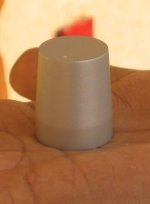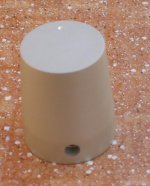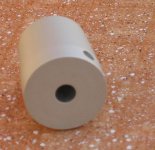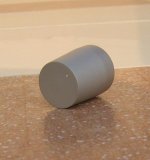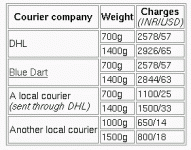I fell in love with these knobs the first time I saw them. They are part of a surplus stock the manufacturer had, because his customer who ordered the set could not pick them up. See the post titled "Uncle Harry's knobs" in this thread. There are still about eighty of them left; I picked up 20 for myself. I don't think they'll be available again, and they're so beautiful I can't take my eyes off them. So I thought I'd post some pics here, in case any of you are interested in contacting the manufacturer and asking him to ship you some.
Attachments
The knobs are made of what Uncle Harry calls "S1" grade aluminium, which takes anodising well, he says. They have a base diameter of 25mm, a top diameter of 22mm, and a height of 30mm. Their shaft diameter is 6mm. Each knob has one screw to grip the pot shaft. The knobs have been finished in what Uncle Harry calls "fine grain finish". This finish basically makes it take on a matte finish, and lose the metallic shine some of the Japanese manufacturers like Denon seem to be so fond of.
Attachments
The rear of the knob is flat. This means that there is no recess to accomodate and hide the locking nut and the tip of the shaft of a panel-mounted shaft. If you use this knob on a flat panel where you mount a panel-mounted pot, then the knob will remain a few millimetres raised off the panel's surface. This may not look very good. The original designer had decided to have a second metal plate behind the front panel, and mount the pot on that sheet. That way, the locking nut and the bush tip of the pot would remain below the top surface of the front panel.
In order to do this, you need to have a hole of perhaps 17-20mm dia on the front panel, into which the locking nut could comfortably disappear, and a hole of the appropriate size on the second metal sheet, where the pot could be mounted. (My pots which I get in Bombay need a 7mm hole.) The knob would cover the 17mm hole, and would float a millimetre above the front panel.
Alternately, you'll need to make a cutout of 27mm on the front panel, and "sink" the knob by an mm or two into the front panel. That way, the knob would appear to emerge from behind the front panel. That looks sexy too. But whatever you do, the point to note is that these knobs don't have a recess to hide the panel-mounted pot, hence they need a more complex front panel design. Caveat emptor.
In order to do this, you need to have a hole of perhaps 17-20mm dia on the front panel, into which the locking nut could comfortably disappear, and a hole of the appropriate size on the second metal sheet, where the pot could be mounted. (My pots which I get in Bombay need a 7mm hole.) The knob would cover the 17mm hole, and would float a millimetre above the front panel.
Alternately, you'll need to make a cutout of 27mm on the front panel, and "sink" the knob by an mm or two into the front panel. That way, the knob would appear to emerge from behind the front panel. That looks sexy too. But whatever you do, the point to note is that these knobs don't have a recess to hide the panel-mounted pot, hence they need a more complex front panel design. Caveat emptor.
Attachments
These knobs apparently have been double-anodised. I don't know what that means, but as per Uncle Harry, this means that their protective coating is more tough and will hold their finish longer. Apparently, this involves anodising the knob twice. Metal specialists like Peter Daniel may have much more knowledge about these things.
The original customer did not want any marking on the knob to indicate angular displacement. I wanted something, anything, but I didn't see how I could use a plain knob. So I asked Uncle Harry to put some mark. He said that a finished flawless knob cannot be put into a vice or jig without damaging its finishing, hence he agreed to just touch one point on the front surface with a thin drill bit, just drilling an indentation on it. Therefore, these have been done after the anodising, which is not the ideal way to do it. But I don't think it'll affect the rest of the knob, and I'm happy with it. The rest of his stock is unmarked. He can either mark them for you the way I've got mine done, or you can pick them up unmarked.
The original customer did not want any marking on the knob to indicate angular displacement. I wanted something, anything, but I didn't see how I could use a plain knob. So I asked Uncle Harry to put some mark. He said that a finished flawless knob cannot be put into a vice or jig without damaging its finishing, hence he agreed to just touch one point on the front surface with a thin drill bit, just drilling an indentation on it. Therefore, these have been done after the anodising, which is not the ideal way to do it. But I don't think it'll affect the rest of the knob, and I'm happy with it. The rest of his stock is unmarked. He can either mark them for you the way I've got mine done, or you can pick them up unmarked.
Attachments
If any of you want to buy some, I think you can contact Uncle Harry (i.e. Mr.Behari Valecha) directly; contact me for his phone number. I presume he'll be happy to ship you knobs, marked or unmarked, if you remit him the price plus the shipping costs in advance. I paid about a dollar (USD) each for them; he may charge you a little more. Plus there will be the not inconsiderable shipping costs; the knobs are solid aluminium.
I refer to Mr.Valecha as Uncle Harry because of his avuncular demeanour; he's not in any way related to me, either personally or professionally.
The thing I really loved about the knobs is their shape. That gentle organic taper, very understated, very elegant, is about as beautiful a shape as any I've seen anywhere, on a system of any price. Mate these with a good large (2-incher) knob for volume control, and you have a front panel to die for. Or else, one can use two of these knobs on a minimalist preamp, one for input and one for volume.
I'm also thinking of getting some larger knobs made from Mr.Valecha. They'll probably be 50mm in diameter (that's probably the largest that you can conveniently fit on a 2U chassis), between 30 and 35mm in height, will be precisely cylindrical in shape, and will have exactly the same colour and finish as the knobs here. These knobs will have a skirting and recess at the rear to accommodate the lock-nut of the pot. See my post here about what I'm thinking. If some of you want to participate, Mr.Valecha will be very pleased, I guess. But I have no idea of the precise final price, so you'll have to get into this with only a vague idea of how much it'll cost you. And shipping cost will be another unknown, which will only be determined once we know the finished size and weight.
I refer to Mr.Valecha as Uncle Harry because of his avuncular demeanour; he's not in any way related to me, either personally or professionally.
The thing I really loved about the knobs is their shape. That gentle organic taper, very understated, very elegant, is about as beautiful a shape as any I've seen anywhere, on a system of any price. Mate these with a good large (2-incher) knob for volume control, and you have a front panel to die for. Or else, one can use two of these knobs on a minimalist preamp, one for input and one for volume.
I'm also thinking of getting some larger knobs made from Mr.Valecha. They'll probably be 50mm in diameter (that's probably the largest that you can conveniently fit on a 2U chassis), between 30 and 35mm in height, will be precisely cylindrical in shape, and will have exactly the same colour and finish as the knobs here. These knobs will have a skirting and recess at the rear to accommodate the lock-nut of the pot. See my post here about what I'm thinking. If some of you want to participate, Mr.Valecha will be very pleased, I guess. But I have no idea of the precise final price, so you'll have to get into this with only a vague idea of how much it'll cost you. And shipping cost will be another unknown, which will only be determined once we know the finished size and weight.
Shipping costs....
I have been doing some homework on the shipping costs, specifically to the US, after Paul (Hilgeman) contacted me with the idea of a group buy. I have bought 20 knobs, so I had a sample set to weigh. This set weighs 700 grams. If I ship 40 knobs, with packing, that'll be about 1500 grams.
I asked around, and shipping costs can be very high if I, as a retail customer, approach one of the smart international courier firms with one packet. Blue Dart has a Website in case you want to know who they are. The local couriers, who have bulk deals with the same int'l couriers for int'l shipping, are much less expensive. I created a table (in HTML) of the rates I'm getting from different couriers, and converted it into an image to attach here. Of these, the last one is a company which has a long-standing contract with my friend's company and has proved very reliable for int'l delivery. They are also very inexpensive. I can therefore ship the knobs through them; my friend will help me.
The USD amounts are not 100% precise; I took an approximate rate of Rs.45 = 1 USD, and randomly truncated/rounded off the figures. But you get the general idea.
Tarun
I have been doing some homework on the shipping costs, specifically to the US, after Paul (Hilgeman) contacted me with the idea of a group buy. I have bought 20 knobs, so I had a sample set to weigh. This set weighs 700 grams. If I ship 40 knobs, with packing, that'll be about 1500 grams.
I asked around, and shipping costs can be very high if I, as a retail customer, approach one of the smart international courier firms with one packet. Blue Dart has a Website in case you want to know who they are. The local couriers, who have bulk deals with the same int'l couriers for int'l shipping, are much less expensive. I created a table (in HTML) of the rates I'm getting from different couriers, and converted it into an image to attach here. Of these, the last one is a company which has a long-standing contract with my friend's company and has proved very reliable for int'l delivery. They are also very inexpensive. I can therefore ship the knobs through them; my friend will help me.
The USD amounts are not 100% precise; I took an approximate rate of Rs.45 = 1 USD, and randomly truncated/rounded off the figures. But you get the general idea.
Tarun
Attachments
- Status
- This old topic is closed. If you want to reopen this topic, contact a moderator using the "Report Post" button.
